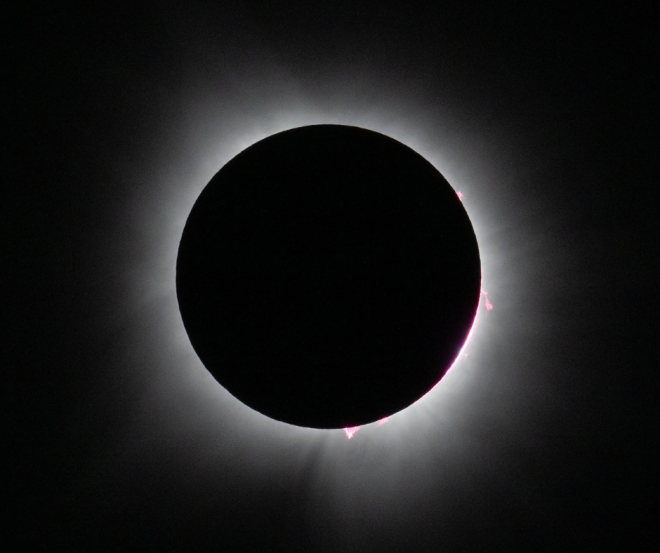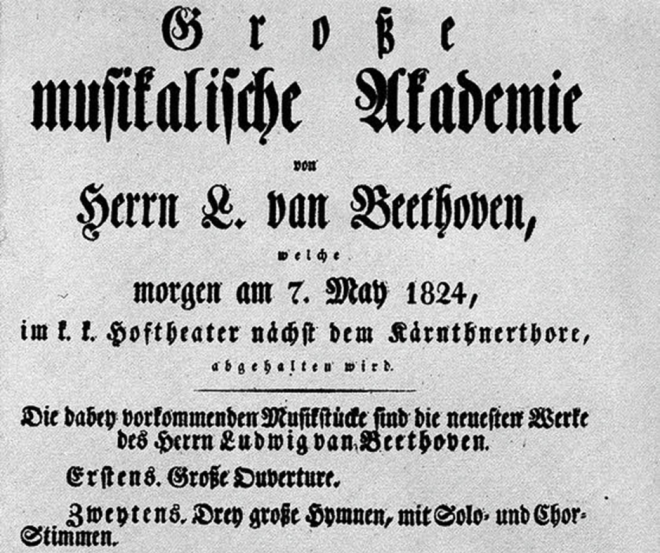On May 7th, we are celebrating the 200th anniversary of the premiere of Beethoven's 9th Symphony - a masterpiece beloved by our listeners and music lovers world-wide. The work, premiered on May 7, 1824, has brought meaning of beauty, love, and unity in this chaotic world over two centuries, and continues to serve as a symbol of hope and peace today. See below to learn about our on-air celebrations, read about the history of the premiere, reflect on the work's universal message, and more.
On-Air Features
Enjoy each of the four movements throughout the day, and join us at the 8PM for a special presentation of the entire symphony.
- 8:36AM: II. Molto vivace (National Symphony Orchestra/Gianandrea Noseda)
- 11:42AM: IV. Finale: Presto (Monteverdi Choir/Revolutionary & Romantic Orchestra/John Eliot Gardiner)
- 2:30PM: III. Adagio molto e
cantabile (Vienna Philharmonic/Andris Nelsons) - 5:33PM: I. Allegro ma non troppo,
un poco maestoso (Vienna Philharmonic/Simon Rattle) - 8PM: A special presentation of the entire symphony with James Jacobs
Blogs
Podcast Episodes
Fun Facts About Beethoven's Ninth
· Today is the 200th anniversary of the premiere of Beethoven’s Ninth Symphony.
· It took place Friday, May 7, 1824 at 7:00 pm in Vienna’s Theater am Kärntnertor (Carthinain Gate Theater), now the site of the Hotel Sacher.
· The all-Beethoven program also included the Consecration of the House Overture and three sections of Missa Solemnis (Kyrie, Credo, Agnus Dei) sung in German to comply with Vienna’s strict rules about the use of liturgical material in public spaces.
· The size of the orchestra was between 82 and 100 musicians, drawn from the theater’s house orchestra, the Vienna Society for the Friends of Music, and amateurs.
· It was the largest orchestra ever assembled by Beethoven.
· There was also an 80-voice chorus and four vocal soloists. The alto soloist, Caroline Unger, was 20 years old at the premiere and was the one who turned Beethoven around at the end of the performance so he could see the standing ovation.
· It was commissioned by the Philharmonic Society of London, which performed the work on March 21, 1825. Beethoven didn’t send them the score until after the Vienna performance took place.
· Beethoven wasn’t originally planning to premiere the symphony in Vienna; he thought they had succumbed to Rossini fever and wouldn’t appreciate a new complex symphony. He was making plans to have the premiere in Berlin, but when his friends heard about this they gathered signatures for a petition to persuade Beethoven to hold it in Vienna.
· The premiere was a triumph, and there was a second performance at the same theater by the same performers on May 23 (which did, however, add a Rossini aria to the program at the insistence of the theater’s management. Sigh.)
· Friedrich Schiller wrote An die Freude (“Ode to Joy”) in 1785, inspired by his friendship with Christian Gottfried Körner, who took him in when he was having legal and financial difficulties and introduced him to his salon, a quasi-Utopian gathering of artists and philosophers.
· While Beethoven had long thought about setting Schiller’s poem (and had made several previous attempts at doing so), and had also long thought about a symphony in d minor, they didn’t coalesce until 1822, when he was already deep into the composition of the symphony. The finale was originally intended to be instrumental, and he ended up repurposing that material as the finale to his String Quartet in A minor, op. 132.
· The first words we hear sung, O Freunde, nicht diese Töne! Sondern laßt uns angenehmere anstimmen, und freudenvollere (Oh Friends, no more of these sounds! Instead let us play notes of joy and pleasure!), are not by Schiller, but by Beethoven himself.
· There is no evidence for the myth that Schiller’s poem was originally called An die Freiheit (“Ode to Freedom”), which we now know to have been concocted by Beethoven’s biographer Alexander Thayer. What is true, however, is that the poem’s original last stanza began with the line “Rettung von Tirannenketten“ (Rescue from the chains of tyrants), which he cut when he revised the poem shortly before his death in
1805, the version Beethoven used, and that this cut was likely made for the same reason Thayer said he changed its original title, out of fear of Vienna’s aggressive censors.
· Despite knowing its dubious provenance, Leonard Bernstein substituted “Freiheit” for “Freude” when he conducted an orchestra of musicians from around the world at the site of the quickly-disappearing Berlin Wall on Christmas Day 1989.
· The melody (but not the words) of Ode to Joy was arranged by Herbert von Karajan to serve as the Anthem of the Council of Europe and the European Union.
· The American premiere took place May 20, 1846 by the New York Philharmonic at Castle Clinton, the first American immigration station before the opening of Ellis Island.
· A performance of Beethoven’s Ninth described in The National Daily as “its first presentation in Washington” took place Tuesday, February 17, 1925 at Poli’s Theatre, 1424 Pennsylvania Avenue NW (demolished in the 1930s to make way for the Federal Triangle). Walter Damrosch conducted the New York Symphony with a local chorus of Washington singers and soloists Ruth Rogers, soprano; Helena Marsh, contralto; Fraser Gange, tenor; and Charles Stratton, baritone. There was no other work on the program, which began with a lecture about the symphony by Dr. Damrosch at the piano.
· On December 6, 1930, Serge Koussevitsky conducted the Boston Symphony Orchestra in a program of Beethoven’s First and Ninth Symphonies at Constitution Hall. (Fraser Gange was again the tenor soloist.)
· On January 20 and 21, 1943, Hans Kindler conducted the National Symphony Orchestra at Constitution Hall in two performances of Beethoven’s Ninth preceded by Leonore Overture no. 3 with the combined voices of the Washington Choral Society, the George Washington University Glee Club, the New York Avenue Presbyterian Church, and the choir from Mount Vernon Place Methodist Church in Baltimore. The soloists were Juanita Carter, Jean Handzlik, John Hamill and Howard Vanderburg.
WETA Passport
Stream tens of thousands of hours of your PBS and local favorites with WETA Passport whenever and wherever you want. Catch up on a single episode or binge-watch full seasons before they air on TV.

